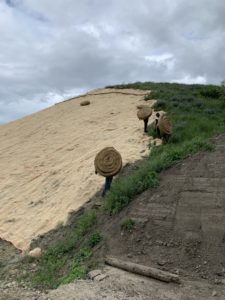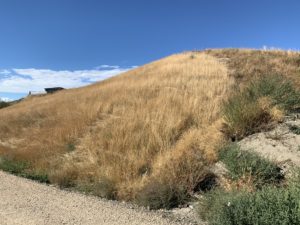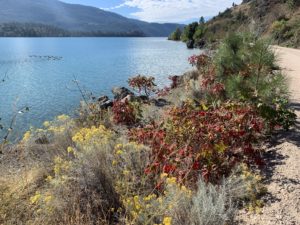Work has begun and will continue over the next several weeks to re-create natural landscaping at the northern gateway to the Okanagan Rail Trail. This means periods of single lane traffic for the first 300m of the trail. Please cooperate with instructions on site, and pause to enjoy the on-going process of converting what was previously a rail car shunting yard into the Kilometre Zero trailhead for this popular trail.
Long term plans for Kilometre Zero include a plaza and seating areas, hilltop viewpoint, and art and interpretive installations. Interpretation will share stories of the historical and contemporary place of the Syilx indigenous peoples in this area known as K’ək’maplqs (or Little Head of the Lake). The first phase of development is to surround the plaza and trailhead with native plant landscaping.
The Friends of Okanagan Rail Trail and Ribbons of Green Trails Society received grants from TD Friends of the Environment, the Okanagan Basin Water Board, and Regional District of North Okanagan to help support planning and design work and native plant restoration. Public donations are also supporting the project.
The Ribbons of Green Trails Society has been an advocate for the Greater Vernon trail network for over the last 25 years, and with much of the original vision now accomplished, the group has turned more attention towards trail management. “Much of our group’s recent discussion has focused on trailside amenities”, says Harold Sellers, president of Ribbons of Green. “This includes native vegetation that both provides habitat, and connects trail users with nature. We are concerned about the proliferation and spread of weedy invasive plants along our trails, and the TD Friends of Environment grant will get this new trailhead off to a good start with a coverage of diverse native plants.”
The Okanagan Basin Water Board has also contributed towards native plant restoration. “By placing a priority on environmental restoration at this creekside trailhead area we will continue to build best practices for other areas along the rail trail”, says Anna Warwick-Sears, Executive Director of Okanagan Basin Water Board. “This project also provides a model to encourage local landowners to chose drought-resistant native plants for their landscaping needs”. Planted areas will only need to be watered for the first year or two until they are established, and there is no need to apply fertilizers, pesticides, or herbicides.
Registered professional biologist, Carrie Nadeau with Associated Environmental (part of Associated Engineering Group of Companies) working with Sagebrush Nurseries has developed a plan to enhance soils by incorporating RDNO Gro and creating the best conditions for native plants to thrive. The palette of native plants that will adorn this site are typical of what would be found in local grassland natural areas, and include plants that are culturally important to the Okanagan Indian Band.
Native plant restoration and weed management is difficult, especially in dry climates and with the challenges of climate change. The restoration work at Kilometre Zero and elsewhere along the rail trail will create the best chances for nature to thrive, and this is especially important along our shorelines and waterways. Trail users can help ensure success by staying on the trail and avoiding disturbance to restoration areas.
There is still time to donate towards development of the Kilometre Zero trailhead. Visit https://okanaganrailtrail.ca/donate/ to find out more.


In May, this steep slope at Kilometre Zero was hydro-seeded with native grassland seed mixture, and covered with natural fibre matting. Four months later, there is a healthy growth of grasses that will diversify over time and include the iconic Arrowleaf Balsamroot, or Okanagan Sunflowers.

Native vegetation provides beautiful fall colour along the Kalamalka section of the Okanagan Rail Trail. It also provides riparian habitat and helps to stabilize the shoreline and protect it from wave action.
